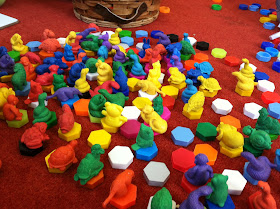It’s that time of year again, when teachers spend hours
paging through catalogs and websites, scouring stores, and brainstorming ideas
for what we want in our classrooms this year. There’s something exciting about a
new school year filled with new materials, and a classroom prepared and ready
for the next set of children to walk through the door.
As I browse through photos, descriptions, and ads, I’m
sometimes reminded of a scene from the movie “Big”, in which Tom Hanks’
character is a toy designer. At a product meeting, as the executives pass
around their newest toy design based on their best research, Tom Hanks says “I
don’t get it.” After hearing what the toy can do, he says, “But what’s fun
about that?” That scene sums up the disconnect that often happens between
the best intentioned play materials, and the reality of how children use (or
don’t use them) in the classroom. I would alter Hanks’ question slightly.
Instead of asking “What’s fun about that?” I’d ask, “What’s interesting about
that?” or “What’s engaging about that?”
Or, if I were a child I would ask, “What can I do with this?”
The first time I saw a basket of wood circles, or a basket
of glass beads, I didn’t see how they could be engaging to children. And
perhaps, sitting there in their baskets, they weren’t all that engaging. There
is nothing automatically magical about any materials, whether it’s a
store bought plastic toy, recycled reusables, or natural objects. The
secret is in how we present them to children, how we craft an environment that
suggests not what the child should do
with the materials, but prompts the child to think what could be done with the materials. Where in the room we place them,
what we pair and group together, what we draw attention to.
Our goal is to create an environment that replaces “I don’t get it” with “What can I do with this?"









